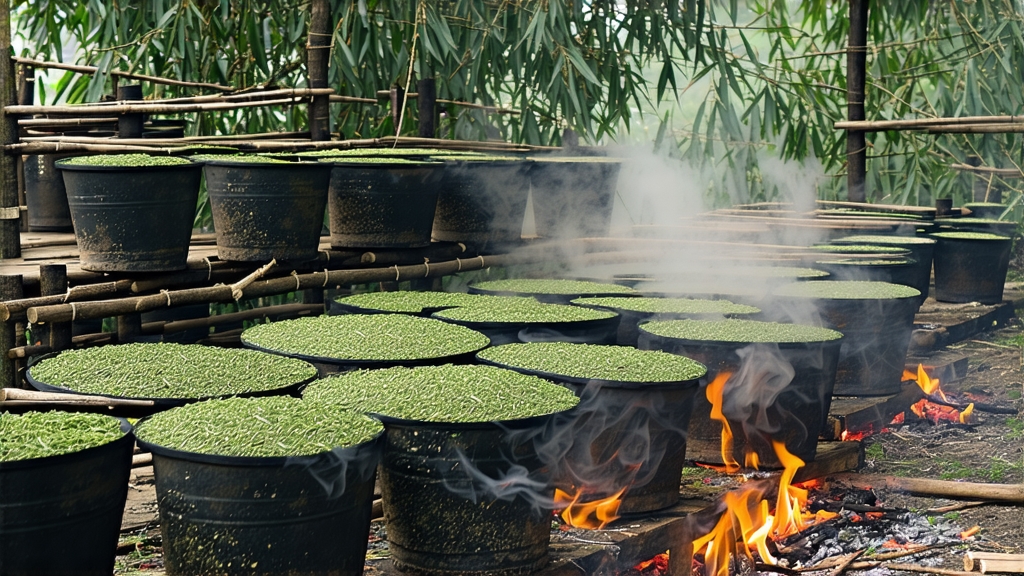
Ask most tea lovers to name a Chinese black tea and the answer is often Keemun or Dian Hong; few realize that the very first black tea ever created still glows in the mountain mists of northern Fujian. Lapsang Souchong—spelled “Zheng Shan Xiao Zhong” on its home soil—was born in the Wuyi Mountains around 1568, a happy accident born of military urgency and peasant ingenuity. Legend says that passing armies commandeered a Qing-era tea factory; to dry the leaves before they spoiled, farmers rushed them over fresh pine fires. The resulting liquor, kissed with resinous smoke yet still sweet underneath, became an instant favorite of Dutch traders who carried it to Europe, where it inspired the English habit of “bohea” and, ultimately, the entire genre of black tea.
Today the name is applied to two very different styles. Traditional Lapsang Souchong (Zheng Shan Xiao Zhong) is still crafted within the 60 km² core of the Wuyi National Nature Reserve, using only two tender leaves and a bud plucked above 800 m from the original Xiaozhong cultivar. Its cousin, the so-called “smoked” or “Russian caravan” version, is produced outside the reserve and intentionally scented with extra pine smoke for export markets. Purists seek the former: a tea whose gentle ember note is a by-product, not a flavoring, and whose aftertaste carries the fragrance of longan, dried lychee and Wuyi mineral rock.
The craft begins before dawn in late April, when mountain air is thick with camphor and azalea. Pickers climb narrow slate paths to groves tucked between cliffs, selecting only the smallest, most uniform shoots. The leaves are withered first in the shade of the cliffs, then on bamboo trays set over dying pine embers. The smoke is not allowed to flare; instead, a thin blue veil drifts upward for six to eight hours, dehydrating the leaf while impregnating it with volatile terpenes that will later marry with natural sugars. Rolling follows, done by machine today yet still checked by touch: the leaf must twist into tight, glossy strips without breaking the surface cell walls too soon. Oxidation is brief—90 minutes at most—because Wuyi nights are cool and enzymes work slowly. Finally the strips are baked twice: once over soft pine charcoal to arrest oxidation, then again at lower heat to coax out the signature honey note. The entire process is finished before the sun rises the next day, locking in a fragrance that will continue to refine for months.
To taste Lapsang Souchong at its most nuanced, abandon teabags and porcelain pots. Instead, reach for a small Yixing clay gaiwan or a white porcelain gongfu set. Use 5 g of leaf for 120 ml of water, heated to 90 °C rather than a full boil; boiling water exaggerates smoke and flattens sweetness. Rinse once, pouring off within five seconds to awaken the leaf. The first proper infusion should steep only ten seconds; it will pour the color of late-autumn sherry and release an aroma that moves from pine sap to baked peach in a single breath. Subsequent infusions—twelve, fifteen, twenty seconds—unfold like chapters: dried longan, roasted sweet potato, a faint touch of wet slate, and finally a cooling camphor finish that lingers at the back of the throat. A good leaf yields eight to nine rounds before surrendering, each softer than the last until only a whisper of smoke remains.
Judging quality is a sensory triangulation. First, examine the dry strip: it should be slender, jet-black with occasional golden tips, and smell of pine without acridity. Second, listen to the wet leaf after the third infusion; when rubbed between fingers it should rustle like parchment, never mush, releasing a scent of honeyed pipe tobacco. Third, taste for balance: smoke must ride on sweetness, not swamp it. A top-grade Wuyi Lapsang will leave the palate clean, ready for food; lesser versions coat the tongue with a creosote bitterness that no amount of milk can soften.
Food pairing follows the tea’s dual personality. The traditional pine-smoked style loves cured meats: think Jinhua ham, Italian bresaola, or Scottish smoked salmon. Its resinous edge also t